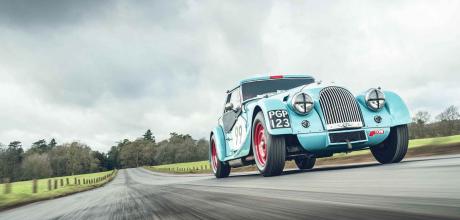1960 Morgan Plus 4 Racer Fabled Lawrence Tune Morgan's ongoing tale
This fabled Lawrence Tune Morgan Plus 4 has been competing in top-flight events for six decades. Julian Balme unravels its incredible history.
Photography Jordan Butters.
PLUS POINTS
The 26th RAC Tourist Trophy Race at Goodwood, for the racing cognoscenti at least, was a slightly disappointing affair. Far from international, the 29-car field of 1961 lacked ‘named’ competitors from outside the sceptred isle and failed to sport an example of the UK’s new flagship sports car, the Jaguar E-type. It did, however, boast the cream of UK talent, such British Racing Drivers’ Club luminaries as Stirling Moss, Mike Parkes, Roy Salvador!, Innes Ireland, Jim Clark and Graham Hill, with a supporting cast of John Whitmore, Peter Lumsden, Les Leston, Peter Jopp and Chris Lawrence.
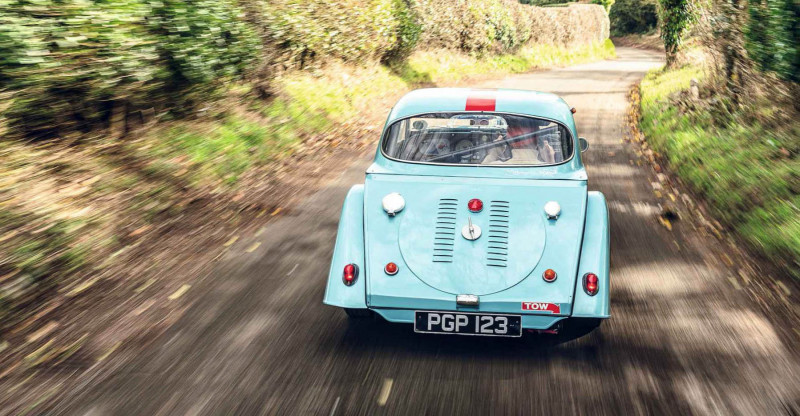
The latter was making a name for himself with his tuning business and his exploits with a Morgan Plus 4, registered TOK 258. Partnering him in the quasi-works Morgan team and lined up alongside him for the Le Mans start that August day was Richard Shepherd-Barron in another famous Moggie, XRX 1. No slouches, they lapped at exactly the same speed (83.24mph) on the first day of practice in their hotted-up (if aged) sports cars. Yet they weren’t the only ones to be flying the flag for the Malvern marque that day. Further down the timing sheet was a third Morgan, registered PGP 123, driven by one Peter Marten. It’s the car you see here.

‘ITS NOT SO HAPPY POOTLING ABOUT BUT ABOVE 3500RPM IT REALLY COMES ALIVE’
Marten had motorsport in his blood: his father raced an MG Midget before the war at Brooklands. When barely 24 years old, Peter spent most of 1960 competing in an early Ford-powered Lotus 7; his sister Shelley took up the sport, too, her weapon of choice being a Turner. This wasn’t Peter Marten’s first Morgan; he’d owned a Series II4/4, and spannered for a work colleague who raced one. In 1960 he saw the early cowled-front Plus 4 on a London forecourt, and was no doubt encouraged by the aforementioned Shepherd-Barron, whom he’d met via Shelley.
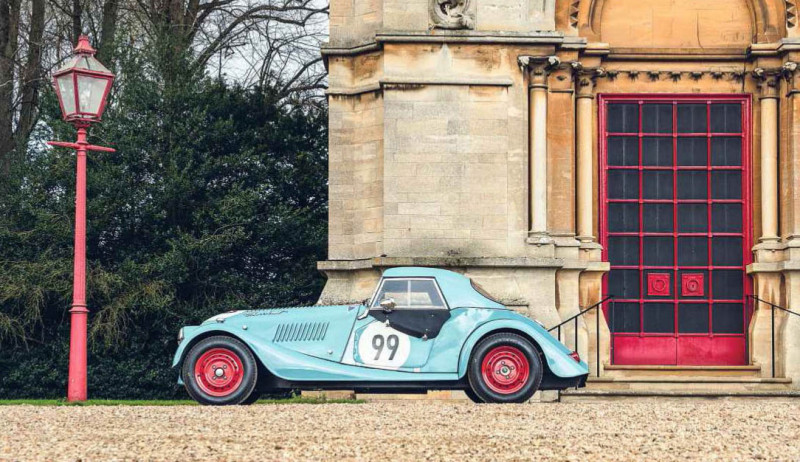
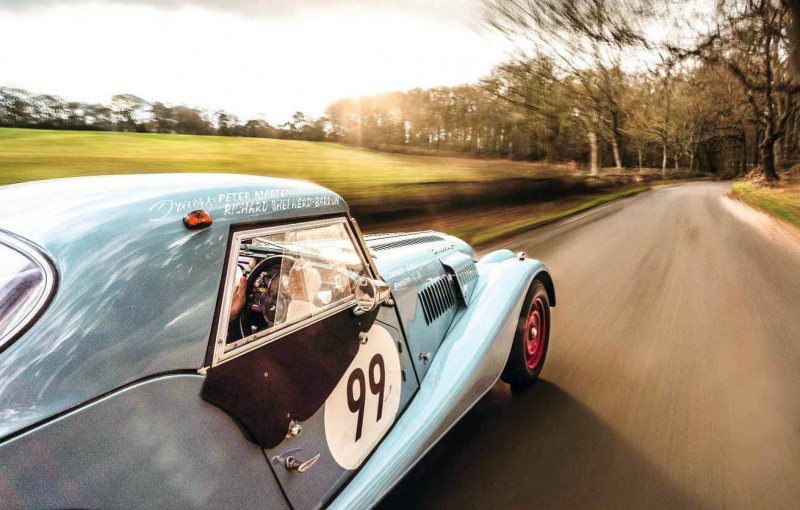
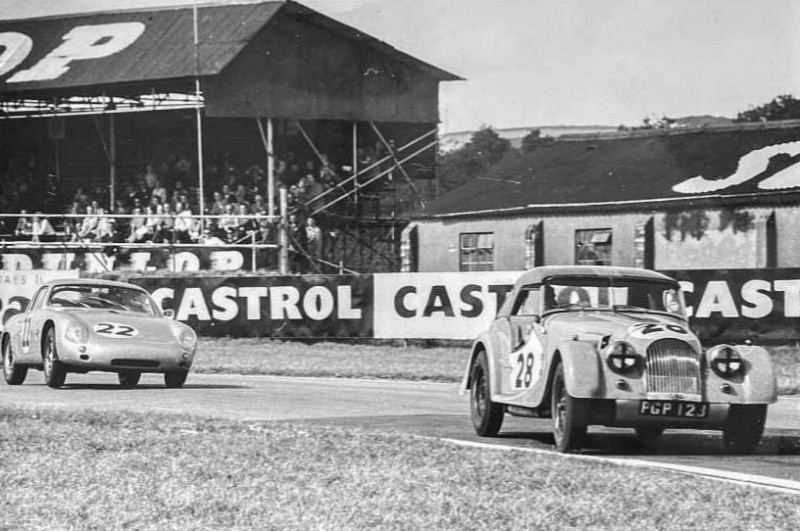
The car had been dispatched from the factory six years earlier, sold through London dealer Basil Roy and sporting Ivory White bodywork.
Marten took his new would-be racer to Snetterton for a GT race in the October to establish whether he was going to take up Richard’s offer and become Lawrence Tune’s first customer. Needless to say, he thoroughly enjoyed himself and threw his lot in with the new concern.
Although the company was billed as a Morgan specialist, proprietor Chris Lawrence had been involved with the cars barely two years. In 1958, the wannabe racing driver had calculated that his best chance of remaining in the game was to contest the BARC’s newly established Freddie Dixon Trophy series. From the eligibility list he deduced that, although the Triumph engine was eminently tunable, it would be better deployed in the chassis of a Morgan, rather than a TR2 or 3. Just within his budget, and for sale at Performance Cars on the Great West Road, was a 1956 Plus 4, registered TOK 258. In his autobiography, Lawrence recalls: ‘I set to work on the car, removing everything that was not needed for racing.’
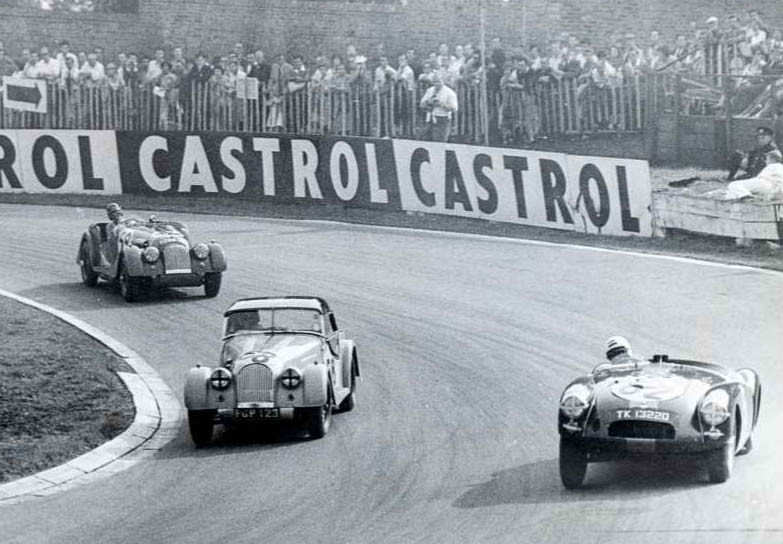
After a disappointing debut at Aintree, where he finished last but studied the opposition, Lawrence returned with the savvy and the determination to improve the Morgan. For just a fiver he acquired an experimental exhaust manifold from Servais Silencers in Kilburn, before entering the last two races of the 1958 season, both held at Goodwood.
‘The manifold turned out to be a masterpiece,’ Lawrence wrote. ‘I then bought an up-to-date set of front discs from the Morgan factory.’ He also had the H4 carburettors looked at by a firm called WHM Burgess on the North Circular, carried out further porting work on the head, adapted the chassis to accommodate longer secondary pipes and invested in KLG spark plugs. The performance gain was reflected in fourth-place finishes in both races and Lawrences theory was proved right, the Triumphs being quicker on the straights and the Morgan better through the corners.
‘DRIVING TO AND FROM ALL OF THEM, MARTEN AND THE MORGAN CONTESTED 25 RACES THROUGHOUT 1961'
He took on the 1959 season with vigour, using equipment at Rotax, his employer, to design and make his own camshaft. Consequently the carbs were replaced with bigger l3Ain H6s. Having polished the crank and rods, Lawrence machined 11lb from the flywheel; along with new Vandervell bearings, timing chain and sprockets, all was balanced by Laystall before final assembly. T didn’t know that my wild camshaft would require the engine to have a lot more spark advance at the top end, but once that had been discovered, the extra performance was nothing short of shattering.’
With backing promised by his would-be father-in-law Robert Neale, Lawrence formed a company called Westerham Motors Ltd and moved into a ‘temporary’ workshop in Acton. It became permanent as the promise was undelivered and another company, Lawrence Tune Engines, was established. It was there that Marten delivered PGP, his new race car.
Throughout the 1960 season the fledgling outfit dabbled in the new Formula Junior single-seater category as well as continuing with the Morgan. An introduction to engine builder Keith Duckworth led to the use of Weber carburettors, along with the prudent advice that he should specialise in one discipline, rather than spread himself thinly across several. Another improvement to the ageing Morgan was the use of Koni dampers — which saved 20sec per lap at the Niirburgring! Lawrence was confident enough to move up the racing ladder and entered International events such as Silverstone’s Daily Express Trophy and the Goodwood TT.
The car returned to the factory for what Peter Morgan considered a refresh, as it was looking fairly used. However, trouble was brewing between Lawrence and Robert Neale over racing and money. As a result, TOK was impounded — just as discussions were underway between Richard Shepherd-Barron and Lawrence with a view to contesting Le Mans. Unfazed, the pair visited a sympathetic Peter Morgan and came away with XRX 1, an Avion Blue Super Sport, at a very favourable price.
Although Peter Marten’s racing ambitions weren’t quite as lofty, the lessons learnt developing TOK 258 were incorporated into PGP 123. Marten’s contribution wasn’t merely by way of his custom: he also designed the new company’s logo and had their enamel badges made up.
A change in regulations by the FIA meant that for 1961 the Morgans could no longer run with an aeroscreen in the International events: they had to wear a full-size windscreen with a hardtop. The latter was cobbled together by hacking about a TR roof, painted black with a join running down the middle that was badly disguised with a deep red Sin stripe. The red was not the same shade as the car’s steel wheels and neither did the pale yellow doors match the rest of the Ivory White body. The car was hardly a portrait of elegance but, as Autosport observed of that season’s very first race, held at Brands Hatch, it was ‘a very rapid Morgan’. It won.
Marten’s busy year began with more club events at Brands Hatch and Snetterton, with indifferent results following its victorious debut, but at May’s running of the 45 th Members’ Meeting at Goodwood he claimed a well-fought-for fourth place in the marque race, a position he would improve upon a month later at the 46th by finishing second, just behind Neil Dangerfield’s TR3. Between these events he made his first trip to Europe with the Morgan, invited after being entered by Lawrence and Shepherd-Barron to contest races at Spa and the Niirburgring as part of their team. This would pit the Lawrence Tune trio against a squadron of Porsches, the Morgans’ main adversary in International races.
First up was the ultra-fast Belgian circuit, where team leader Lawrence had a lucky escape after a stub axle failed on the opening lap, yet despite brake issues with his car, Marten finished a creditable sixth in class, while Shepherd-Barron took a fine second. Legend has it that this is where PGP 123 inherited its nickname of‘Choc Ices’. By all accounts the phrase was the punchline to a particularly lewd joke as told by Nobby, one of the Lawrence Tune mechanics assigned to Marten’s car. It tickled Marten to such a degree that he adopted it as a name for his Morgan. T came round to take the chequered flag and Nobby had written “Choc Ices” at the top of my pit board,’ he recalled. T laughed so hard I nearly crashed.’
Buoyed by the result, the entourage moved on to Germany and the 1000kms. With two drivers per car (Lawrence and Shepherd-Barron in XRX, Marten with Bob Staples in a newly released TOK), Choc Ices was used only as a recce car for the drivers to familiarise themselves with the demanding Eifel circuit. This didn’t preclude it from experiencing a drama of its own, however. As Marten wrote in a postcard home: T had a hairy time the other day — front stub axle snapped at lOSmph on a slight bend. My car is OK now -1 didn’t shunt it.’ He flew out to Germany the following week, fitted the new part and drove the Morgan home.
Disaster struck again on 18 June at Snetterton, shortly after that 46th Members’ Meeting. In an email to the car’s future owner Simon Gurney, Marten wrote: ‘During the race, an American driver, who had stalled at the start in a Cooper Jaguar, tried to overtake me at the Hairpin and spun. I managed to avoid the first gyration, but with his second he T-boned Choc Ices.’ Lawrence stepped in and took the all-but-written- off Morgan back to the factory, and it was back on track by the end of July, in the guise it wears today. Rebuilt at cost, it reappeared looking much like its younger cousin, XRX 1, with sloping rear body on a new chassis complete with aluminium panels, including the Super Sports bonnet and scoops. Marten wanted the car left in bare alloy, but Peter Morgan insisted it be painted — in the end, the same pale blue as XRX 1.
A month later the Lawrence Tune trio was back together in West Sussex for the TT, to take on the Porsche Carrera Abarths. They didn’t fare too well. At scrutineering the three Morgans were all weighed and there Choc Ices was shown — much to Lawrence’s annoyance — to be the lightest of the team. At the start, Shepherd-Barron and Lawrence gave chase to Graham Hill and Fritz Hahnl, their pace embarrassing the slower of the two silver coupes, but trouble set in after barely half an hour. Shepherd-Barron had to retire XRX 1 from tenth place due to the back axle showing signs of seizure.
Although Marten’s pace shadowing the TRs and ’Healeys wasn’t shabby, at his first pit stop it was deemed, much to his infuriation, that the faster Shepherd-Barron should take over Choc Ices. T thought I’d been called in for fuel,’ he remembers. ‘I wasn’t best pleased when I was told to get out and hand over to Richard. I wouldn’t mind but he only did two laps before blowing up the engine.’
Of the three Morgans, only Lawrence would finish, completing 100 laps (winner Moss did 109) to come in 11th overall, third in class — four laps behind class-winner Hill in the Porsche Carrera Abarth GTL.
When asked if he found the company at Goodwood intimidating, Marten recalls: ‘Not nearly as much as at the ’Ring. There were all sorts out there. Phil Hill, Jo Bonnier, Dan Gurney, Von Trips. What was nice was that the British boys like Moss would always give you a wave of recognition as they passed.’
Driving to and from all of them, together Marten and Choc Ices contested 25 races throughout 1961, from clubman events to high-profile Internationals. Resplendent in its pale blue livery, the Morgan even took a second overall win at Mallory Park at the end of September. I won a bloody alarm clock that’s never worked,’ Marten remembers. Such commitment to racing was inevitably a drain on his finances and, following a last hurrah at Brands Hatch on Boxing Day in which he finished third behind the other two Lawrence Tune Morgans, he put Choc Ices up for sale and — much to his regret — hung up his helmet.
Bill Jones, an acquaintance of Shepherd-Barron’s, stepped up and took on the Morgan and, although it would be 50 years before Choc Ices revisited the circuits of Europe, he raced it extensively at home during 1962, mainly at Goodwood, though not in the blue-riband TT. Jones changed the car’s colour to a more sombre British Racing Green and, for reasons unknown, the registration to 550 DXN.
With his mechanic, Ken Foley, he ran the car independently of Lawrence Tune for the remainder of the 1960s before moving it on. Few owners followed, yet all of them drove it competitively. In the hands of its next owner, John MacDonald, Choc Ices spent the 1970s and 1980s contesting club events and then, from the 1990s until today, it had many outings as a historic racer, firstly with Jan Bulinski and then Simon Gurney before its current custodian, Kevin Kivlochan.
All left their mark on the car. Bulinski retrieved its original registration from the DVLA and shared a drive at the Silverstone Classic with Chris Lawrence. From 2010 Gurney developed it into a very competitive race car, not only taking it back to Spa but also following in TOK’s tyre-tracks and taking on the Le Mans Classic twice. He also had the honour of taking Choc Ices back to its spiritual home in West Sussex, racing at the Goodwood Revival and Members’ Meetings.
On acquiring the Morgan in 2021, Kivlochan repainted the car in its 1961 TT scheme of Avion Blue with red steel wheels, racing it sparingly between outings in his Cobra and Morgan Plus 8. The attraction? ‘It’s a stunningly balanced car and a joy to race. It looks like it should be slow, but it punches above its weight, especially in the rain.’
That sentiment is echoed by Marten: ‘It was terrific in the wet. At somewhere like the ’Ring, where the weather was so changeable, it really worked well. We certainly got the better of the TRs whenever it rained.’
It’s not too bad in the dry either. These days, hot TR engines push out nearly 200 brake. Fed by Webers and coupled to the Morgan’s lightweight body, that makes for a rapid old car. It’s not so happy pootling about, with lots of spitting and fluffing from the Italian carbs, but above 3500rpm it really comes alive. With a surprisingly slick four- speed gearbox, the car invites the driver to hustle it along, though as the speed increases, avoiding potholes is paramount as it is quite stiffly sprung and the chassis passes any crash or bang through to the cabin and the driver’s backside, which feels perilously close to the tarmac. Thankfully the steering has lots of feel and is even more responsive to quick changes of direction when shod with Dunlop racing tyres.
The low-cut doors and sidescreens are not dissimilar to those of its Triumph TR2/3 nemesis, though it does feel slightly roomier, and all it lacks is a place to put one’s left foot when not operating the clutch. The idea of bowling down into Eau Rouge without being able to brace oneself would, for most drivers, be quite disconcerting. That, though, would be the only qualm about what really is a capable and complete driver’s package. One that performs well beyond its pre-war origins and which, after an exhilarating day at the racetrack, can be driven home. Just like a proper historic racing car.
Clockwise, from right — If car interiors could tell a tale… this one clearly wears its history well; in its element at speed, thanks to its expertly tuned Triumph engine; red steel wheels, hardtop and sloping tail give the Morgan a highly distinctive look.
‘AS AUTOSPORT OBSERVED OF THE 1961 SEASON’S FIRST RACE, HELDAT BRANDS HATCH, IT WAS “A VERY RAPID MORGAN”. IT WON’
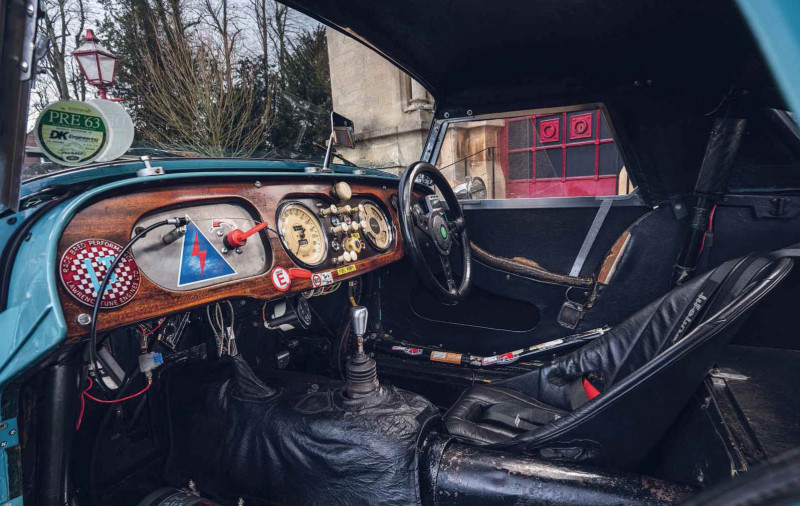
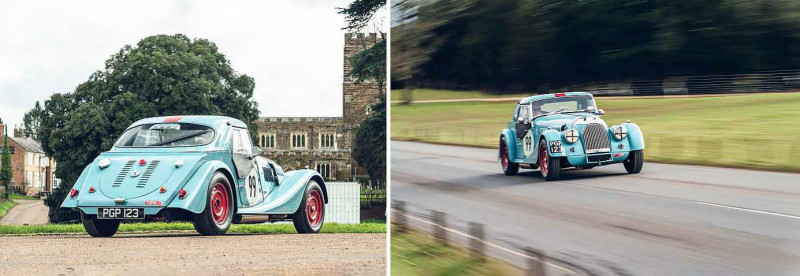
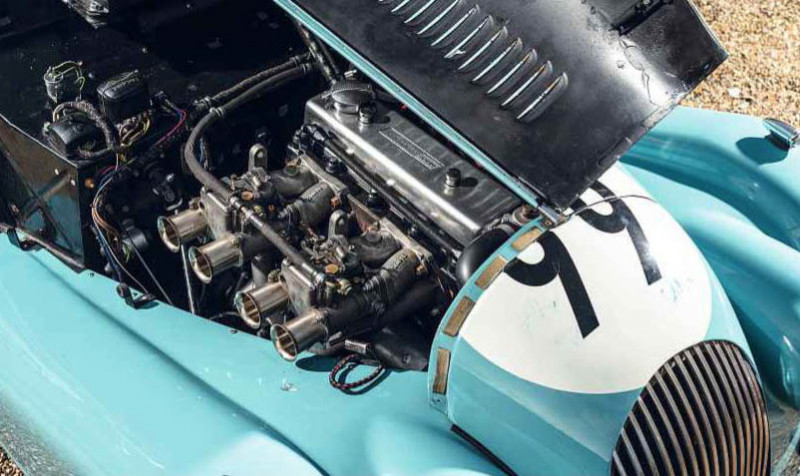
Clockwise, from right 2.0-litre TR3 engine gives nearly 200bhp, thanks to radical Lawrence Tune cam timing, special manifold and twin Webers; on the road here, but it's been a track contender since the early 1960s; windscreen and roof were dictated by 1961 FIA rules.
Clockwise, from above Other racers have frequently seen the Morgan from this angle during its six-decade career; Marten shows Gerhard Koch a clean pair of tyre-treads through Woodcote Corner during the 1961 Goodwood TT; taking the inside line in the September BARC marque race at Crystal Palace.


